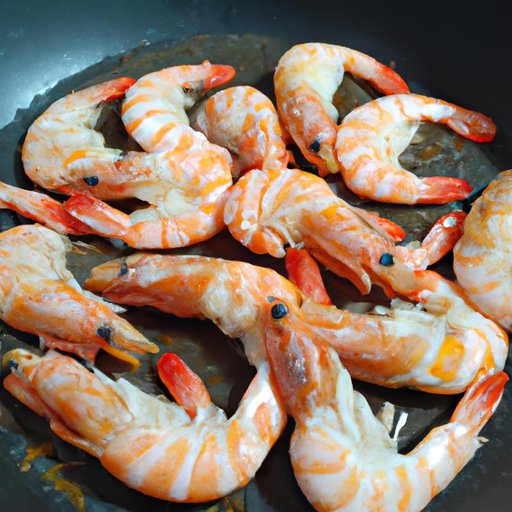
Introduction
Are you tired of struggling to cook shrimp without it becoming rubbery or mushy? Do you want to explore new recipes and flavor combinations with this versatile seafood? Look no further than this article, where we’ll explore how to master the art of sauteing shrimp. With simple tips, tasty recipes, and variations to try, you’ll be a shrimp-cooking expert in no time.
Master the Art of Sauteed Shrimp with These Simple Tips
Before we dive into the delicious recipes and variations, let’s first cover some basic techniques for sauteing shrimp.
We’ll start with the most important tip of all: use fresh shrimp. Fresh shrimp will have a slightly translucent appearance with a firm texture. If it has a mushy texture or a strong fishy odor, it’s no longer fresh and should be discarded.
It’s also important to understand the difference between searing and sauteing. While searing uses high heat to create a brown crust on the outside of the protein, sauteing applies a gentler heat to cook the ingredients through without browning. For shrimp, you’ll want to saute at medium-high heat to prevent overcooking or burning.
For equipment, you’ll need a large skillet or saute pan, preferably with a non-stick surface, and tongs or a spatula for flipping the shrimp. Temperature control is key, so it’s helpful to have a thermometer to monitor the heat of the pan and shrimp.
Timing is also crucial when it comes to sauteing shrimp. Overcooked shrimp will become rubbery, while undercooked shrimp can lead to food poisoning. Cook the shrimp until it becomes pink and opaque, which should only take a few minutes.
From Garlic to Lemon Butter: The Ultimate Guide to Tasty Sauteed Shrimp
Now that you have the basic techniques and equipment down, it’s time to get creative and experiment with different flavors. The possibilities are endless, but here are a few tasty options to get you started:
- Garlic: Heat minced garlic in butter until fragrant, then add the shrimp and saute until pink.
- Lemon butter: Combine melted butter with lemon juice and zest, then pour over cooked shrimp.
- Cajun: Create a spice blend of paprika, cumin, cayenne pepper, and dried thyme, then toss the shrimp in the mixture before sauteing.
Don’t be afraid to mix and match different flavor combinations to find what you like best. You can also try experimenting with different herbs like basil, parsley, or cilantro.
Flip it Right: How to Perfectly Saute Shrimp in a Few Easy Steps
If you’re new to cooking shrimp, it can seem intimidating to flip it during the sauteing process. Here are the steps to follow to get it just right:
- Start with a hot pan and melted butter or oil.
- Add the shrimp to the pan and cook until the first side turns pink.
- Use tongs or a spatula to flip the shrimp over and cook the other side until pink.
- Remove the shrimp from the pan and serve immediately.
It’s important to handle the shrimp delicately when flipping it to avoid breaking it apart. Don’t overcrowd the pan, as this can also lead to uneven cooking.
Healthy and Flavorful: Sauteed Shrimp as a Go-To Dish for Weeknight Dinners
In addition to being delicious, shrimp is also a healthy protein option, as it’s low in fat and high in protein and other nutrients like selenium and vitamin B12. Sauteed shrimp is also quick and easy to prepare, making it a perfect go-to dish for weeknight dinners.
Here are a few recipe ideas to get you started:
- Tomato and Basil Shrimp: Saute shrimp in a simple tomato sauce with garlic and fresh basil.
- Greek-Style Shrimp: Toss shrimp with lemon juice, oregano, and feta cheese for a flavorful Mediterranean-inspired dish.
- Teriyaki Shrimp Stir-Fry: Use sauteed shrimp as the protein in a vegetable-filled stir-fry with a sweet and savory teriyaki sauce.
These recipes are just a starting point, so feel free to get creative and try out your own flavor combinations.
A Seafood-Lover’s Delight: Sauteed Shrimp Variations You Must Try
There are many different types of shrimp available, each with its own unique flavor and texture. Here are a few varieties to look for:
- Gulf shrimp: These are some of the most popular shrimp in the United States, prized for their sweet flavor and firm texture.
- Tiger shrimp: These are large, meaty shrimp with a distinctive reddish stripe on their backs.
- Rock shrimp: These have a texture similar to that of lobster and are a great option for sauteing.
When selecting shrimp, you’ll want to choose the right size and type for your recipe. Larger shrimp may take longer to cook, while smaller shrimp may cook more quickly and can be overcooked easily.
Here are a few recipe ideas to try with different varieties of shrimp:
- Coconut-Crusted Rock Shrimp: Toss rock shrimp in a mixture of shredded coconut and panko breadcrumbs before sauteing.
- Cajun Tiger Shrimp: Use Cajun seasoning to spice up the large, meaty tiger shrimp.
- Gulf Shrimp Scampi: Saute Gulf shrimp with garlic, butter, and white wine for a classic Italian-inspired dish.
Conclusion
Sauteed shrimp is a versatile, delicious, and healthy seafood option that’s easy to prepare at home with a few basic tips and techniques. By starting with fresh shrimp, using the right equipment, and experimenting with different flavors and varieties, you can become a shrimp-cooking pro in no time. Try out the recipes and variations provided in this article, or create your own and discover your new favorite shrimp dish.





